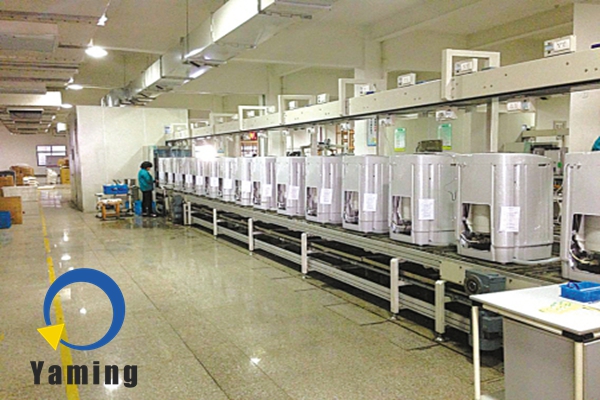A complete washing machine production line is not a superposition of single equipment, but consists of multiple systems that work together. Each system undertakes key production links, ensuring smooth and efficient processes.
1. The parts conveying and distribution system serves as the “logistics hub” of the assembly line. The system mainly uses high-precision belt conveying lines, suspended conveying chains and intelligent sorting mechanisms, and is responsible for transporting thousands of washing machine casings, inner cylinders, motors, control panels, etc. Parts are accurately transported to the corresponding workstation according to the production rhythm.
2. Automated assembly system This is the “core execution unit” of the washing machine transmission line. It uses multi-axis industrial robots, servo press machines, and automatic screw locking machines as the core to complete the automated assembly of key components of the washing machine. For example, in the motor assembly process, the robot can accurately connect the motor with the inner cylinder shaft through visual positioning, with an error of no more than 0.1 mm. At the same time, the bolt tightening is automatically completed, and the tightening torque accuracy is controlled at ±5%, which is 4-6 times higher than manual assembly efficiency, and avoids component damage or uneven torque caused by manual operation; In the assembly of the control panel, the automatic laminating equipment can achieve seamless laminating of the display screen, circuit board and panel, with a yield of more than 99.8%.
3. The performance testing and quality control system is equivalent to the “quality gatekeeper” of the production line. It integrates multiple modules such as water leakage detection, noise testing, operating performance testing, and electrical safety testing to perform full-dimensional testing on each assembled washing machine.
4. The data traceability and production management system serves as the “smart brain” of the assembly line. The system is based on Industrial Internet (IIoT) technology and collects real-time data of the entire production process, including equipment operating status, workstation production progress, parts traceability information, and product inspection data, etc., and generate a unique “identity code”(such as a QR code or bar code) for each washing machine. Enterprises can achieve three major functions through this system: first, real-time monitoring of production line production capacity, such as checking the number of finished products offline per hour and bottlenecks at each workstation, and adjusting production parameters in a timely manner; second, quality traceability. If product problems are discovered subsequently, they can use the “ID code” to quickly query production time, operators, and inspection data to locate the root cause of the problem; The third is to work with the enterprise ERP (Enterprise Resource Planning) system to achieve intelligent collaboration of “production demand-parts procurement-inventory management”, reduce inventory backlog and reduce supply chain costs.
